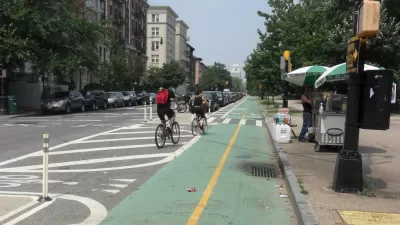Opposition to NYC's bike infrastructure improvements was loud, emotional, and ultimately ineffective. But can planners like Janette Sadik-Khan learn from seemingly unhinged opponents? Planetizen Blogger Josh Stephens decided to ask.

Janette Sadik-Khan reads cities like few others do. She may not, though, have read her Plutarch.
At the recent Journalists Forum on Land and the Built Environment (sponsored by the Lincoln Institute of Land Policy, the Harvard Graduate School of Design, and the Harvard Nieman Foundation), I asked Sadik-Kahn a question straight out of Cato the Younger: “was there any wisdom in the hysteria?”
Let’s back up and discuss why hysteria might be so familiar to a former commissioner of the New York City Department of Transportation. (As if hysteria wouldn’t be familiar to anyone holding that position.)
In her six years serving under then-Mayor Michael Bloomberg, Sadik-Khan famously updated New York City’s streetscape in ways unlike any of her predecessors. I’m sure I’m not the first to compare her to an enlightened Robert Moses, who built much of the city’s mid-20th century infrastructure seemingly by force of will, but it’s still an apt equivalence.
Whereas Moses built bridges and sometimes bulldozed neighborhoods, Sadik-Khan took a lighter approach. She brought pedestrian plazas and green-striped bike lanes to the urban jungle, often using little more than some sawhorses and paint.
Moses’ nemesis, the late, great Jane Jacobs, likely would have approved.
Sadik-Khan is not merely “progressive.” While she fawns over pleasant photos of art students cheerily sketching in a temporary plaza, her progressivism is also based on data, metrics, and an expansive notion of what metrics to follow. She has the metrics about the benefits of bike lanes and the angle of public opinion. And she embraces formerly radical ideas that, though they have been adopted by the younger generation of planners, often have trouble rising through petrified bureaucracies.
She also has a commanding personality.
Sadik-Khan's presentation at the journalists forum focused not just on her accomplishments but also, to her credit, on her detractors. Time and again a vocal minority of New Yorkers challenged Sadik-Khan, often in harebrained ways. She showed headlines and videos describing some of the more vehement and ludicrous accusations about her improvements. Opponents likened bike lanes to the Gaza Strip. They insisted that the city would crumble.
Dorothy Rabinowitz, a member of the Wall Street Journal’s editorial board, famously warned that bike lanes were “totalitarian.” She told New York Magazine that the Citibike bike-sharing program, “is the stuff of your darkest aesthetic dreams. There is nothing human about the racks.” (As if the city's two million or so cars and trucks are nothing but Rembrandt paintings on wheels. And don't get me started on Donald Trump's buildings.)
As Rabinowitz proves, you clearly don’t need a backyard to be a NIMBY.
It’s not hard to imagine that Sadik-Khan shrugged off the criticism, knowing that the correctness of her views and the support of the silent majority (and of Mayor Mike) would win the day. She’s been able to dismiss naysayers in ways that other planners have not. She’s been so dismissive, it seems, that she hasn’t even had to formulate a response to them.
As I tried to explain to Sadik-Khan at the journalists forum, I was wondering – despite her convictions – if any of those activists had ever given her pause or caused her team to alter a project. I was hoping for insight into the mind of someone who has stared down NIMBYism and caused it to turn tail. I suppose that’s what I got.
Sadik-Khan couldn’t even verbalize a response. Literally throwing up her hands and quivering with what I can describe only as condescension, she made it clear that she resented the question, as if I was the one who was hysterical.
A simple “no” would have sufficed.
I asked my question for two reasons: First, regardless of their personal sympathies, journalists have to at least give passing credence to opposing views. Second, as Sadik-Khan knows full well, the opponents whom she brushed aside would have stopped many of her counterparts dead in their tracks. It’s not unreasonable to try to give her the chance to explain how she prevailed if only so that others could learn to follow her lead.
Poor responses to NIMBYs and other conservatives – most notably those of Tea Party supporters, many of whom are taking aim at smart growth – have undermined plans into which many fine planners have put their life’s work. The ability to calmly and empathetically acknowledge, consider, and respond to opposition – not matter how unreasonable it may seem – can be a planner’s greatest asset.
I figured that Sadik-Khan would know how to do this – I know she does. I wanted to see that asset in full bloom, especially since she is one of our greatest planners. I wanted to be able to write a blog with insight that I could have conveyed from her to the rest of the planning world. I was hoping that Sadik-Khan might be an ambassador for tough, but thoughtful, planning and would demonstrate that she could be both eminent and sympathetic. Instead, I found myself intimidated and belittled.
That’s one way, I suppose, to get things done. Make some plans, run some numbers, answer only the questions you like, and give your opponents the occasional icy stare. For what it's worth, the cyclists of New York are definitely better off for Sadik-Khan's efforts -- and so is (almost) everyone else.

Trump Administration Could Effectively End Housing Voucher Program
Federal officials are eyeing major cuts to the Section 8 program that helps millions of low-income households pay rent.

Planetizen Federal Action Tracker
A weekly monitor of how Trump’s orders and actions are impacting planners and planning in America.

Ken Jennings Launches Transit Web Series
The Jeopardy champ wants you to ride public transit.

Driving Equity and Clean Air: California Invests in Greener School Transportation
California has awarded $500 million to fund 1,000 zero-emission school buses and chargers for educational agencies as part of its effort to reduce pollution, improve student health, and accelerate the transition to clean transportation.

Congress Moves to End Reconnecting Communities and Related Grants
The House Transportation and Infrastructure Committee moved to rescind funding for the Neighborhood Equity and Access program, which funds highway removals, freeway caps, transit projects, pedestrian infrastructure, and more.

From Throughway to Public Space: Taking Back the American Street
How the Covid-19 pandemic taught us new ways to reclaim city streets from cars.
Urban Design for Planners 1: Software Tools
This six-course series explores essential urban design concepts using open source software and equips planners with the tools they need to participate fully in the urban design process.
Planning for Universal Design
Learn the tools for implementing Universal Design in planning regulations.
Heyer Gruel & Associates PA
Ada County Highway District
Institute for Housing and Urban Development Studies (IHS)
City of Grandview
Harvard GSD Executive Education
Toledo-Lucas County Plan Commissions
Salt Lake City
NYU Wagner Graduate School of Public Service



























